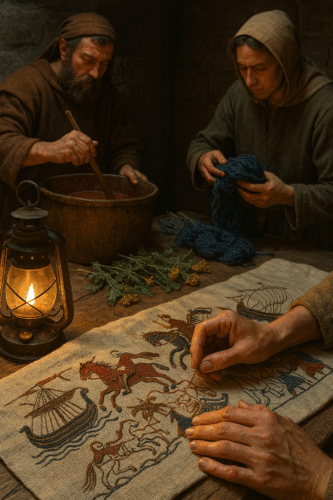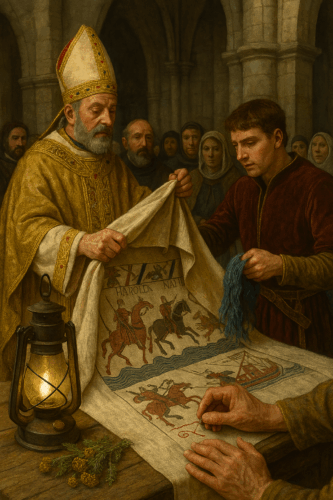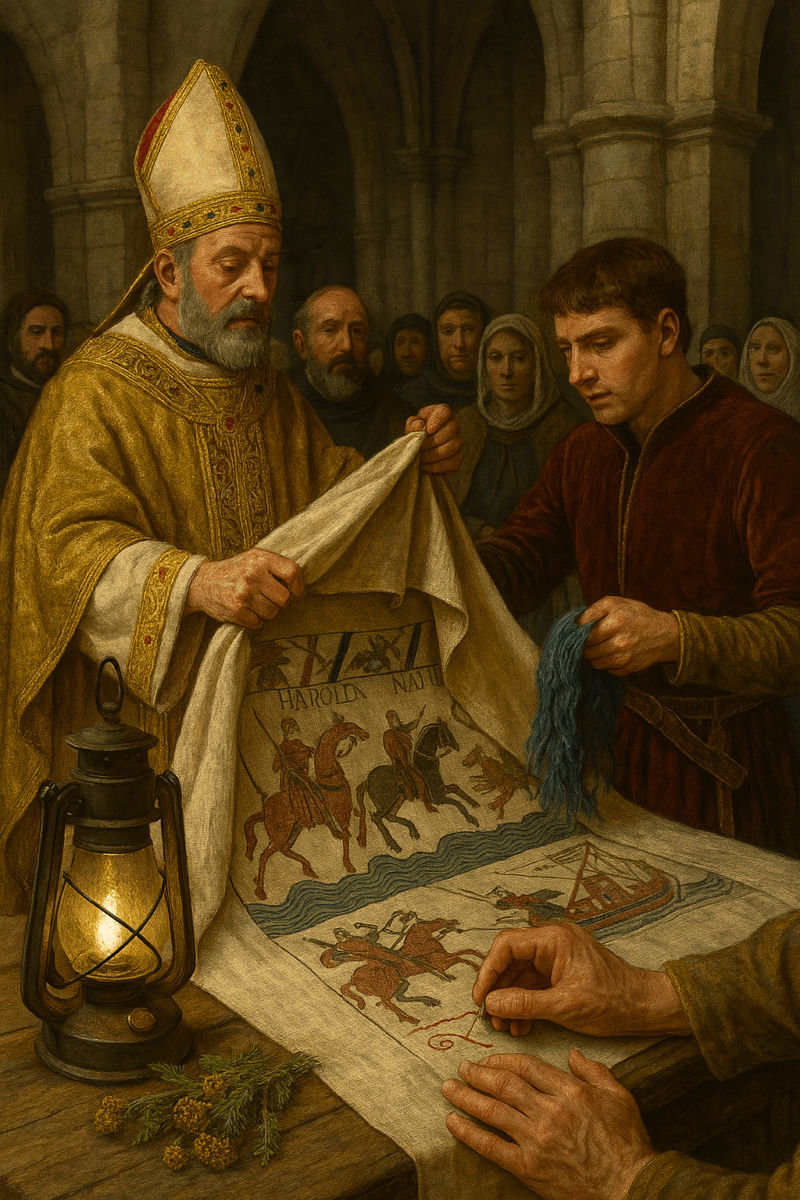July 14, 1077. In the newly consecrated nave of Notre-Dame de Bayeux Cathedral, a colossal embroidered cloth was unfurled before an assembly of Norman nobles, clergy, and artisans. This work—the Bayeux Tapestry—would become one of the most remarkable artifacts of medieval Europe, narrating conquest, politics, and craftsmanship in vivid stitch and dyed thread.
Over nine centuries later, its story remains a testament to the power of narrative art, collaboration across disciplines, and foresight in preserving legacy. By exploring the tapestry’s origins, creation, first display, and centuries-long journey, we unearth practical lessons that enrich our own lives and projects today.
 A Canvas of Destiny: Origins of the Bayeux Tapestry
A Canvas of Destiny: Origins of the Bayeux Tapestry
The Bayeux Tapestry is more than a decorative cloth; it is a monumental chronicle. Commissioned in the mid-1070s, it spans nearly 70 meters of linen, embroidered in woolen yarns dyed with madder red, woad blue, and weld yellow. Its scenes depict events from 1064—when Harold Godwinson visits Duke William of Normandy—to the Battle of Hastings in October 1066.
Medieval textile workshops were hubs of exchange: local weavers provided the linen; dyers extracted pigments from plants and minerals; embroiderers—likely a team of skilled women—applied each stitch. It took roughly a year to complete, an extraordinary feat given the scale and detail: horses, ships, castles, and personae rendered in continuous narrative, border scenes of mythic beasts and Latin captions guiding the viewer.
In an age before print, images served as mass communication. The tapestry functioned as both propaganda and pedagogy: it legitimized William’s claim to the English throne, illustrated the Norman conquest as divinely sanctioned, and educated an illiterate elite on recent history.
This ensemble of artisans, clergy, and patrons epitomized medieval collaboration. Funding came from Bishop Odo—William’s half-brother—while ecclesiastical authorities cleared space for display and consecration, blending spiritual ritual with political theatre.
By July 1077, the tapestry’s narrative arc was complete: a visual manifesto woven into each thread. Its first public show would cement its status as a living document of conquest and piety.
- Normandy and England: A Fractured Landscape
In the mid-11th century, Normandy was an ascendant duchy—its dukes ambitious, its knights battle-hardened, its economy buoyed by agricultural surpluses and coastal trade. Across the Channel, England faced dynastic disputes. King Edward the Confessor died childless in January 1066. Harold Godwinson took the crown, but William of Normandy claimed Edward had promised him succession.
Politics in both regions hinged on feudal oaths—ties of loyalty cemented by ceremony and symbol. Harold’s alleged oath to William, depicted in the tapestry, would become the linchpin of Norman claims and English resistance.
By summer 1066, William assembled a fleet of ships, mercenaries, and vassals. He landed in Sussex, clashed at Hastings, and killed Harold. Yet conquest did not end with victory: it demanded pacification, fortification, and administrative overhaul—castle-building, land redistribution, and the introduction of Norman institutions into English life.
The tapestry, created over a decade later, reflects both triumph and reconciliation. It acknowledges English fortifications and local actors, even as it emphasizes Norman valor. In revealing multiple perspectives, it indicates a nuanced approach to newly integrated rule.
The assembly at Bayeux Cathedral on July 14, 1077, thus became a potent symbol: a joint Norman-Anglo event underscoring unity under the new ducal and ecclesiastical order.
- The Art of Embroidery: Techniques and Materials
Mid-11th-century artisans relied on locally available materials and inherited techniques. The tapestry’s linen ground was hand-woven from flax—its strength ideal for long-term preservation. Wool yarns came from regional sheep breeds, selected for their dye affinities.
Dyers used natural sources:
- Madder root produced vibrant reds.
- Woad leaves yielded shades of blue.
- Weld and dyer’s rocket herbs gave bright yellows.
These pigments were fixed with alum mordants, creating colorfast fibers that endures nine centuries later. Embroidery employed the “lay-and-stitch” method: threads laid across the surface then stitched down, enabling broad fields of color and fine detailing in animals, armor, and facial expressions.
Artisans organized work in scenes. A master designer sketched preliminary outlines—cartoons drawn on linen or waxed wood. Teams would then divide tasks: one group filling backgrounds, another tackling figures and borders. An experienced overseer ensured narrative cohesion.
Borders, often overlooked, are a marvel in themselves. Mythical creatures—griffins, centaurs, hybrid beasts—frame the main story, echoing medieval bestiaries and moral allegories. Each micro-scene subtly comments on the central panel, enriching the viewer’s reflection on heroism, vice, and divine order.
Such technical mastery underscores the value of specialized roles working toward a shared vision—a principle as relevant to modern projects as it was to medieval embroidery.
- Consecration of Notre-Dame de Bayeux: Ritual and Magnificence
Bayeux Cathedral was consecrated on July 14, 1077, by Bishop Odo and Archbishop Maurilius of Rouen. Consecration ceremonies blended liturgy, relic veneration, and public spectacle. The cathedral had been under construction for decades; its architecture combined Norman solidity with emerging Gothic ambitions—impressive stone vaults, arches, and ports.
On that midsummer day, clergy, local dignitaries, and pilgrims flooded the nave. Lanterns hung from timber roofs, incense wafted through aisles, and choirboys intoned Gregorian chants. Amid this sacred ambiance, the tapestry was unfurled upon a raised wooden dais, transforming the nascent cathedral into a visual theater.
The act of display served multiple purposes:
- Reinforcement of noumenal authority—Bishop Odo demonstrated both spiritual leadership and familial influence.
- Didactic showcase—parishioners and visitors witnessed their own recent history dramatized in stitch, hearing Latin captions chanted by deacons.
- Civic celebration—markets, feasts, and performances extended beyond the nave, as townsfolk marked the occasion with dancing, minstrel songs, and communal meals.
The cathedral’s dedication and tapestry unveiling marked a turning point: Bayeux emerged as both a spiritual hub and a cultural landmark, drawing pilgrims en route to Santiago de Compostela and scholars from across Europe.
- The First Unveiling: Witnesses and Reactions
Contemporary chroniclers—though sparse—hint at the awe inspired by that morning’s tableau. William of Poitiers, chaplain to Duke William, lauded the tapestry’s “vivid recounting of divine favor upon rightful rule.” Scribes recorded letters from neighboring bishops praising the artistry and doctrinal clarity.
Local nobles, including Anglo-Norman lords newly granted fiefs in England, viewed the tapestry as confirmation of their social elevation. It commemorated their participation in battle, immortalizing their deeds for posterity. Peasant onlookers, though illiterate, absorbed basic moral lessons: usurpation leads to turmoil, rightful leadership ensures peace under God’s providence.
Reactions varied by class. Clerics focused on the tapestry’s theological overtones—miracles, the sanctity of oaths, and rebukes of perfidy. Secular elites admired the martial pageantry—ships brimming with knights, siege engines at Hastings, heraldic devices stitched with precision.
This multi-layered impact explained the decision to leave the tapestry permanently displayed in the cathedral for weeks. Pilgrims and traders who arrived months later still found it prominent, discussing its details and quoting its captions—a medieval equivalent of social media virality.
- A Tapestry’s Journey Through Centuries
Following the Norman period, the tapestry’s fate winded with political and religious upheavals. During the Hundred Years’ War, it was allegedly hidden in a wooden chest under the cathedral floor to protect it from English and French marauders alike. In 1476, it was transported to Paris for King Louis XI’s jubilee and exhibited in Notre-Dame de Paris.
By the 18th century, interest waned. Enlightenment critics dismissed it as quaint relic. But preservationists resurfaced when antiquarians like Camille de la Croix rediscovered it in 1803, noting its fragile state. Napoleon Bonaparte ordered its transfer to the Bibliothèque Royale—modern France’s nascent national library. It hung along walls like a linen scroll.
In 1832, it was moved to the Hôtel de Cluny (now the Musée national du Moyen Âge), where scholars measured, catalogued, and produced hand-colored lithographs. Restoration efforts in the 20th century stabilized the linen, removed old linings, and returned it to Bayeux Cathedral in 1984 under climate-controlled glass cases.
Throughout these centuries, the tapestry served alternating roles:
- Political symbol—invoked by French and English monarchs to justify claims.
- Scholarly artifact—studied by art historians, linguists, and medievalists.
- Tourist magnet—drawing tens of thousands of visitors annually to Bayeux.
Its survival underscores the importance of stewardship: dedicated custodians safeguarded it through wars, neglect, and environmental threats. Their foresight allows us to stand before this 11th-century masterpiece today.
- Modern Scholarship: Deciphering Medieval Codes
Contemporary historians and art scholars dissect the tapestry’s layers. Textual experts study the Latin captions—mingled classical idioms and Norman French influences—tracing scribal conventions and translation variants. Archaeologists compare depicted fortifications and ship designs to excavated remains, confirming details of 11th-century military architecture.
Iconographic analysis reveals nuanced messages. For instance, scenes of Harold’s oath-taking by holding sacred relics underscore Norman claims to his perjury. Border sequences—lions attacking oxen, dragons consuming foes—serve allegorical warnings against betrayal and hubris.
Digital humanities projects now apply high-resolution imaging and spectral analysis, uncovering pigment compositions and faded details invisible to the naked eye. Virtual reconstructions let global audiences experience the tapestry’s original colors—once thought muted, now revealed as surprisingly vivid.
By decoding these elements, scholars continually refine our understanding of medieval politics, social mores, and artistic networks. The tapestry becomes a springboard for interdisciplinary research—combining textile studies, political history, theology, and conservation science.
- Significance and Symbolism: A Legacy in Threads
Why does a stitched narrative from 1077 still captivate? The Bayeux Tapestry achieves several feats:
- It merges art and text into a seamless story—anticipating modern comics and graphic novels.
- It demonstrates craft as communication—an early infographic conveying complex events to diverse audiences.
- It embodies collaboration across social strata—patrons, artists, clergy working in concert.
At its core, the tapestry reminds us that legacy depends on how we record and share our stories. A single individual’s perspective—bishop, knight, or artisan—finds voice in a communal artifact. Each stitch is a decision: what to include, emphasize, or omit.
For today’s reader, the tapestry is a metaphor for project documentation, brand storytelling, and personal memoir. It shows that vivid detail, coherent narrative, and enduring design can outlive centuries of upheaval.
- Threads of Meaning: Life Lessons from Bayeux
Beyond the medieval milieu, the tapestry offers timeless principles:
- Narrative power: We are wired for stories. Crafting a compelling sequence—beginning, conflict, resolution—engages hearts and minds more than raw data.
- Collaborative creation: Monumental achievements require diverse talents. Seek partners who contribute unique skills.
- Durable design: Materials matter. Choosing quality means your work can withstand time and scrutiny.
- Visual communication: Images transcend language barriers. Integrate visual elements to amplify your message.
- Legacy mindset: Document processes and outcomes. Your future self—and others—will thank you.

These lessons fuel motivation by linking concrete medieval practice to modern ambitions. They urge us to think beyond immediacy, to conceive projects that resonate long after their inception.
- From Stitches to Strategy: A Personal Action Plan
How can you apply these medieval insights to your own life, work, or creative project? Below is a six-week plan to craft your personal “tapestry”—a coherent, visually rich narrative of your goals, achievements, and values.
Week 1: Vision and Storyboarding
- Define your core theme (e.g., career growth, artistic journey, community impact).
- Sketch a timeline of key milestones.
- Identify visuals or metaphors that align with each milestone.
Week 2: Collaborative Mapping
- List individuals or resources to involve (mentors, designers, editors).
- Schedule brainstorming sessions.
- Assign roles—who will research, who will design, who will draft text.
Week 3: Material Selection
- Choose your medium (digital portfolio, printed booklet, video series).
- Gather or create assets (photos, infographics, illustrations).
- Ensure quality—high-resolution images, cohesive font and color palette.
Week 4: Craft and Composition
- Draft narrative sections, integrating visuals.
- Apply consistent styling: headings, captions, transitions.
- Solicit feedback from collaborators; refine tone and clarity.
Week 5: Preservation and Presentation
- Select a platform or venue (website, social media, live event).
- Test display across devices or settings.
- Prepare backup copies and documentation for future updates.
Week 6: Unveiling and Reflecting
- Launch your project with a small event or online announcement.
- Invite your audience—friends, colleagues, community.
- Collect responses; record lessons learned for iteration.
 By following this structured plan, you mirror the medieval tapestry’s creation: deliberate phases, specialized skills, and a launch that celebrates communal achievement.
By following this structured plan, you mirror the medieval tapestry’s creation: deliberate phases, specialized skills, and a launch that celebrates communal achievement.
- Weaving Modern Narratives: Beyond the Plan
Your personal tapestry need not be literal embroidery. Consider:
- A dynamic website with interactive timelines.
- A video documentary intercut with hand-drawn illustrations.
- A printed zine combining poetry and photography.
- A LinkedIn series mapping professional milestones with infographics.
Whatever form you choose, emphasize:
- Continuity: Keep your narrative cohesive from start to finish.
- Detail: Small anecdotes resonate—like a stitch capturing a horse’s gait.
- Context: Situate your story within broader trends or historical precedents.
These choices amplify impact, ensuring your work endures intellectually and aesthetically.
Conclusion: Stitching Past and Future
On July 14, 1077, medieval minds consecrated both stone and stitch. The Bayeux Tapestry—born of political maneuvering, artistic mastery, and spiritual ceremony—has transcended its original moment to become an immortal narrative.
Today, by emulating its principles—story-driven design, cross-disciplinary collaboration, quality materials, and legacy thinking—we chart our own paths toward projects that inspire, educate, and endure. Let the threads of Bayeux guide your craft, and may your personal tapestry, whether digital or tangible, stand as a testament to vision woven through time.

